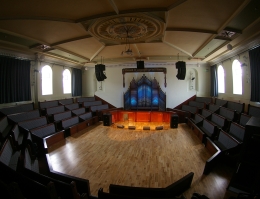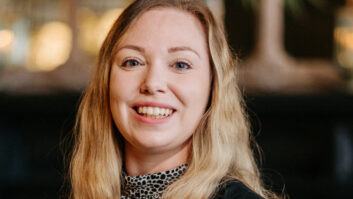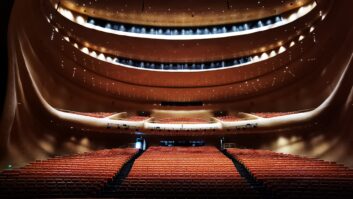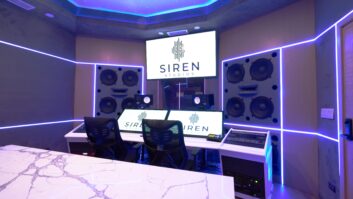
A historic 18th century Grade II-listed congregational church in Merthyr Tydfil, Wales has been restored following a six year bid to secure development grants.
Following a spend of £1.4m, the building, which had fallen into disrepair, has been converted into a multi-cultural arts, community, educational and Welsh Language Centre, incorporating a new 250-seat amphitheatre; this has been equipped with an end-to-end Harman Pro sound system, supplied by UK and Ireland distributors, Sound Technology, and installed by Adlib.
The project is the brainchild of the Soar Project’s chief officer, Lis McLean, who secured a total of 13 grants – including £527,000 from the Heritage Lottery Fund and £300,000 from Heads of the Valleys funding programme – with contributions coming from their own Welsh language bookshop, based in the adjacent vestry opposite. She says the dream for a Welsh community centre of this nature had its origins as far back to 1987.
The driving force behind the flexible multimedia technology – which would bridge the auditorium with dance studios and recording rooms downstairs – was local musician and former London-based pro audio specialist Tim Gray. Brought in to advise Ms McLean, the former Harman Pro reseller contacted his close associate Nick Bellis at Sound Technology. At a site meeting both men agreed that a line array was the only solution.
“I presented Lis with my recommendation of a system design that would not only work for their requirements, but be the best system in the valleys,” said Gray. “In this amphitheatre setting there is not a bad seat in the house so it seemed only right that we should be able to distribute transparent, evenly-dispersed sound throughout.”
Harman Pro Applications Engineer, Tom Williams, took EASE measurements of the room, and based on his plots several different line array options were considered to handle the wide dispersion, before the technical team voted in favour of a JBL VRX solution.
To achieve a consistent coverage pattern for a wide range of performance – from male voice choirs to musicals, community drama and all aspects of the arts – the project required a professional team of contractors that could provide a complete technical installation, working within the restrictions of a sensitive building.
In addition to the audio, Adlib also equipped the building with conventional lighting bars, dimmer racks and LED effects to highlight the magnificent pipe organ, video projection onto an electric dropdown screen and drapes (provided by J&C Joel) to envelop the room, matched to the Welsh tartan tweed of the reupholstered original pews.
JBL’s VRX system was installed in two phases. Initially, hangs of two VRX932LA enclosures and single VRX918S 18in sub were flown each side in a left and right configuration. The main hangs were later bolstered by a third flown VRX932LA per side, while a centre cluster of two VRX932LA speakers was added during second phase installation works. Along with the flown additions, two pairs of ground-stacked SRX718S’Subs (for use as necessary) and six SRX712M 12in speakers were introduced; four of the latter were used as conventional stage monitors and the other two flown as out-fills across the bleachers.
At the same time a Soundcraft Vi1 digital desk was installed in the theatre’s front-of-house position — described by Tim Gray, who also teaches live sound at Merthyr College, as “a great teaching tool”, with its easy analogue-to-digital transition.
Flexible digital audio networking is under the command of a BSS Soundweb London BLU-160 DSP, configured 8-in/8-out, with a BLU3 wall-mount remote offering local control, and the system is powered by five Crown MA5000i amplifiers (2 x 2500W/4 ohms), with an XTi4000 (2 x 1200W/4 ohms) handling monitors.
Adlib introduced a custom switch panel in the amplifier rack to control audio signal flow within the Soundweb devices. The configuration uses the Logic features within London Architect software to introduce additional auxiliary feeds from the Vi1 console through to each zone of the FOH loudspeaker system to best suit each engineer’s mixing preference.
Soundweb also has the capacity to introduce sources from other areas of the complex on the audio network in the future. In addition to the theatre, the original chapel now houses a dance studio and an exhibition space, as well as music and multi-media rooms, while across the way, the adjacent vestry provides a home for Merthyr’s Welsh Language Centre, a Welsh language bookshop, café and other training and educational areas (it will also be used by the University of Glamorgan and the Urdd).
Led by installation director Roger Kirby, Adlib worked alongside main construction company Maxiom (under the management of Andrew Jones), architect, Geoffrey Cheason from Lapider, and electrical contractors PG Digital (with Peter Thomas managing the project).
Adlib made generous provision for tie lines which will serve the many OB trucks that will visit the building as well as those using the other in-house performance spaces. Stage boxes and patch-bays have been installed in all key areas; as a result, the dance studio, for example, has already been able to double as an orchestra pit.
Microphone signal inputs and returns and comms lines ensure that music from the theatre performance space and dance studio can be captured and recorded in the ground floor studio control room, while separate data lines allow camera and AV feeds signal flow between key points within building.
“We are delighted with the results,” said Roger Kirby. “Being in a Grade II-listed building, speaker positions were critical and having the EASE plots provided a brilliant start; the VRX 932 system was chosen because it packs the punch and for the budget it was perfect. As for the Vi1, with so many theatre shows, the digital snapshots are very useful.”
There are presently 32 input lines (plus onboard FX and digital inputs) but this analog input count can be expanded to 64 in future with the addition of a Compact Stage box. “We have put in place a full FOH returns system and can take an XLR split and run a dedicated monitor feed facility,” added Kirby.
The official opening of the centre takes place in June.







